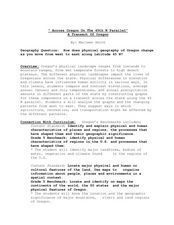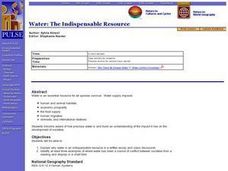Curated OER
Enzymes in Action: An Inquiry Approach to the Effects of Enzymes
Students experiment with enzymes as key components of chemical reactions in all living things through this series of lessons.
Curated OER
Science Excursion: Cover Mapping Land
Students study remotely sensed images and topographic maps to classify land cover types in their watershed area. They take samples in the watershed area to interpret the images.
Curated OER
Understanding the Steps in a Process
Students read, "Center for Drug Evaluation and Research: FAQs", and discuss with questions embedded in the lesson.
Curated OER
Korea in Your Community
Students identify Korean products sold in the US and become aware of Korea's importance in international trade.
Curated OER
What Are the Seasons?
First graders explore seasons and how they are part of a continuous circle.
Curated OER
Gluten and Balloons What Do They Have In Common?
Students examine the purpose of gluten in bread making and what type of flour is needed to make bread. They compare the properties of a balloon to bread dough to explain yeast fermentation. They make bread.
Curated OER
Rotating Rings of Ice
Students work together to develop a model of Saturn and its rings. They identify what types of materials make up the rings and how they revolve around Saturn. They write a short paragraph describing the rings.
Curated OER
Future Conditional
Students examine how toxic pollutants affect environmental and human health. They define key terms, watch a video, and answer discussion questions.
Curated OER
"Across Oregon On The 45th N Parallel" A Transect of Oregon
Young scholars explore the physical geography of Oregon. In groups, students collect weather and elevation information on Oregon. They organize the data and create maps and graphs of the information. Afterward, young scholars compare the...
Curated OER
Where In The World?
High schoolers identify the goods and services from the United States and Mexico. Using postage stamps, they describe the various images they see and place them into categories. They use those categories to determine what is important...
Curated OER
Sunlight Necklaces
Third graders review the placement and role of the sun in the solar system. Using beads, they create a necklace which they can use to identify the amount of sunlight is being illuminated. In groups, they record observations on the...
Curated OER
Investigating the Uses of Backyard Bacteria
Students discover that the answers to some of society's waste and clean-up problems may be no further than the soil beneath their feet. They perform a Gram stain on the colonies to determine some of their characteristics.
Curated OER
Do we Really Need Wild Nature
Students research challenges with which modern biotechnology confronts wild nature. Students collect articles that relate to biotechnology and the environment. Students prepare a collaborative answer to the question, "Do we really need...
Curated OER
How to Celebrate the 800th Anniversary of the Mogol Empire
Students research information on the Mongolian Empire from various readings and online videos of primary sources and create a poster for oral presentation. Students connect history with the current day, while incorporating geographical,...
Curated OER
How Does Climate Affect Our Shelter Needs?
Fourth graders investigate how weather influences shelter choices. They explore the concept of insulation and discuss some traditional Native American shelters. They discuss the shelters used by the Okanogan people during the various...
Curated OER
Adapted to Fire
Fourth graders explore forest species' adaptations to fire by participating in a scavenger hunt and mapping a burned forest. Students create maps and explore how indigenous species adapted to living with fire.
Curated OER
Aphids and Ladybirds
Students record observations of ladybird beetles and aphids. They develop questions concerning the behavior of ladybird beetles and aphids that are testable by a classroom experimentation. Students develop an investigation.
Curated OER
World Geography: Water: The Indispensable Resource
Students are able to explain why water is an indispensable resource in a written essay and class discussion. They identify at least three examples of where water has been a source of conflict between societies from a reading and...
Curated OER
Foods for Better Health
Students define biotechnology and discuss the economic impact of biotechnology. They also describe what a 1015 onion and a slow-softening tomato are and how they are produced. They examine the safety of genetically-engineered or altered...
Curated OER
CALORIE COUNTDOWN
Students will categorize foods according to their components and energy content.1. Design a large bulletin board with sections for carbohydrates, fats and proteins.
2. Ask students to bring labels and packages of different food products....
Curated OER
Goobers. Goobers? Goobers!
Students begin the lesson by noting the many ways in which to use peanuts. In groups, they use the internet to research the work of George Washington Carver. They discover the allergies and nutritional information of the peanut and...
Curated OER
Graphin' And Glyphin' Utah Weather
Fourth graders investigate the concepts of looking at sets of data. The focus of the study is upon the local weather of Utah. They study the weather found in the city and in the country and make comparisons based upon geographical location.
Curated OER
Microorganism Multiplication
Seventh graders complete two experiments to learn about harmful and helpful microorganisms. In this microorganisms lesson, 7th graders read background information about fungi, yeast, and club fungi. Students then complete two experiments...

























